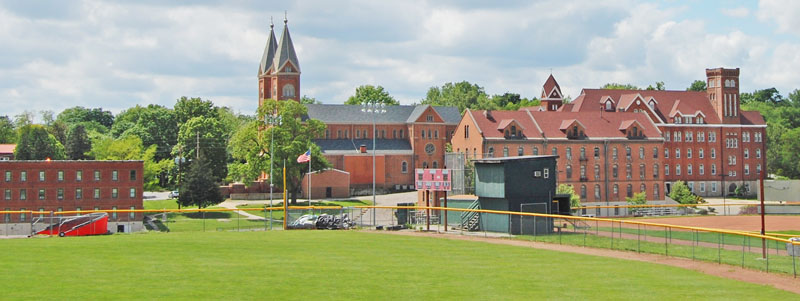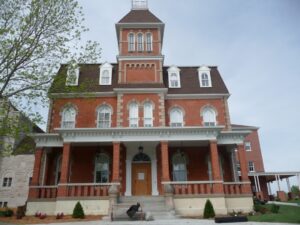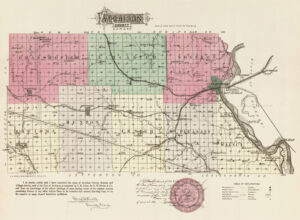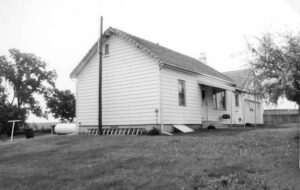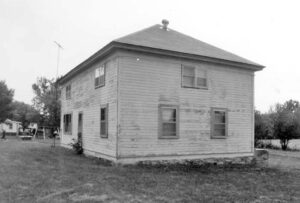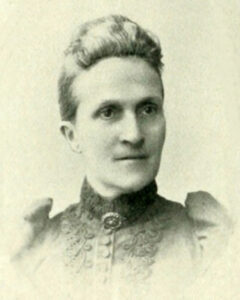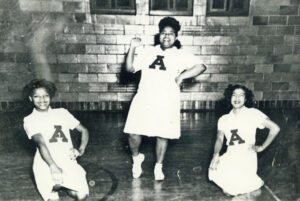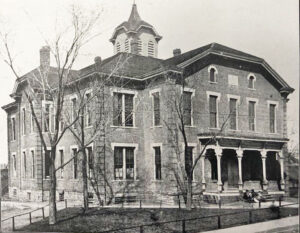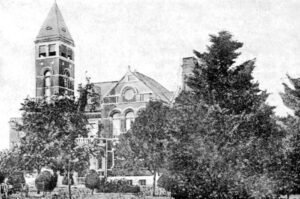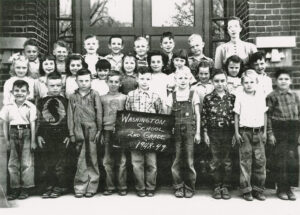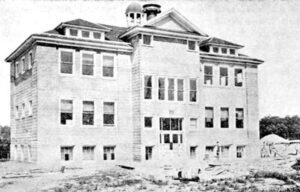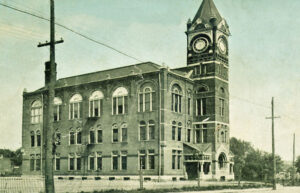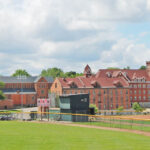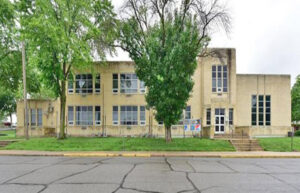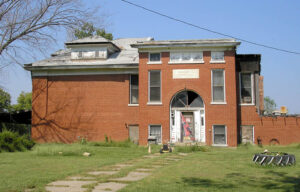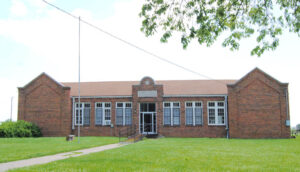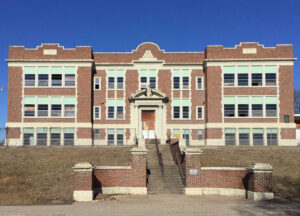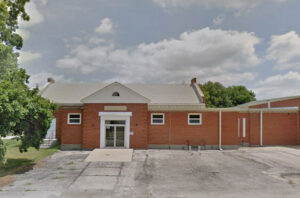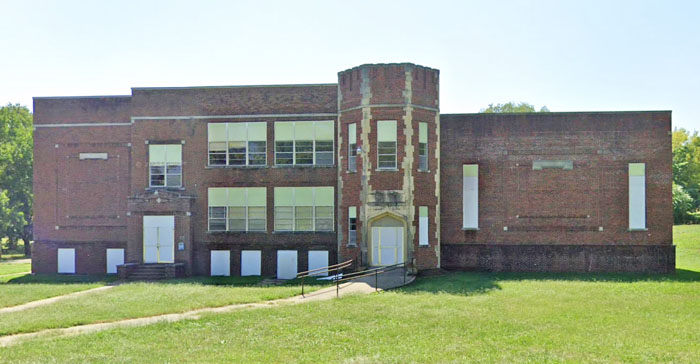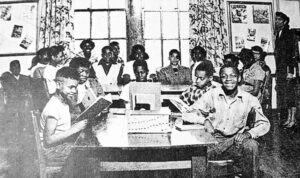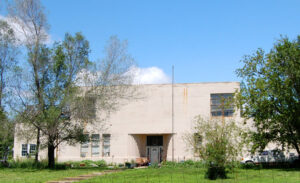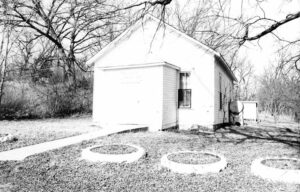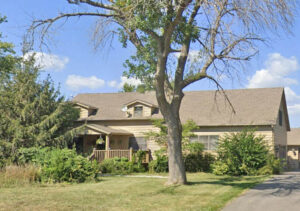Atchison College Institute (1870-85)
Midland College and Western Theological Seminary
The first Territorial legislature passed a law in the summer of 1855, providing for the establishment of 267 common schools. However, the history of the Atchison County school system did not begin until 1858.
The first schools in Atchison, Kansas, were private institutions, and many flourished until after the beginning of the Civil War. The Baptist Seminary, at the northeast corner of Eleventh and Santa Fe Streets, was among those first in the educational field. It was a school for young women and was conducted by Mr. Stork. Later, Mrs. Lizzie Abbott conducted a young ladies’ school at the northeast corner of Sixth and Laramie Streets.
The city of Atchison, District Number 1, was organized on August 5, 1858, by Henry Kuhn, County Superintendent of Common Schools, and the cornerstone of a central building for the city school was laid the same month. On September 13, a meeting was held in the law office of Franklin B. Adams, and school officers were elected, including Phillip D. Plattenburg, who had previously served as county superintendent of Fulton County, Illinois, was elected principal of the schools, and Mrs. Amanda Blair his assistant. A month after the formation of this district, on November 20, the Atchison Free High School was opened in Bury’s new building at the corner of Fourth and Commercial Streets.
Mrs. Blair had her teaching certificate when she arrived in Atchison, as one was issued to her by Dr. Plattenburg in Fulton County, Illinois before she came to Atchison. She was in charge of the primary and intermediate departments. Dr. Plattenburg received a salary of $100.00 a month, and Mrs. Blair’s salary was $45.00, which was increased to $50.00 by Dr. Plattenburg, giving her $5.00 of his own salary. Mrs. Blair had 65 students, and the first spelling match in Atchison County occurred in W.D. Rippy’s school.
During this time, Colonel P. T. Abell, the Treasurer of the School Board, was laboring under a $20,000 bond. There was some difference of opinion as to whether that period of civilization had arrived when the community would be justified in supporting schools.
In 1959, the corps of teachers increased to four, and Miss Lizzie Bay and Miss Melissa Kipp became the other two teachers. The school was moved to the old Masonic building further west on Commercial Street, where it was conducted for two years. Mr. Plattenburg was also appointed county superintendent and the first teacher’s certificate he issued in Atchison County was to D.W. Rippy, the wealthiest man in Doniphan County. Mr. Rippy taught the first school in the Second District, organized near the Waggener farm southwest of Atchison.
The schools occupied rented quarters for ten years, except for two frame buildings in South Atchison. The basement of the Congregational Church, the lower floor of the old Masonic building that stood near the corner of Eighth and Commercial Streets, the upper floor of the Auld building on Commercial Street, near Sixth, Price’s Hall, and probably other buildings were used during those years.
The average length of the school term for the first year was three and a half months, and in some districts, due to the distance and winter climate, the school was held only during the summer months.
That year, three districts were in the county, and the state funds apportioned to Atchison County was $295.30. The school population was 1,941, with an enrollment of 1,072 and an average daily attendance of 500. Twenty-nine teachers were employed, twenty-two women and seven men, with an average monthly salary for the men of $25.20 and $16.75 for the women. The total valuation of schoolhouses was $1,050, and the amount of money received from the county was $827.05.
Mr. Plattenburg served as principal and superintendent of schools until May 1861, when the schools were closed for lack of funds. Because of the Civil War, very little progress in education was made.
In 1863, Mr. Sawyer became the school superintendent and held the office from 1863 to 1867. Mr. Negley followed him.
Among the early teachers in this county were Miss Lizzie Keith, who taught in District No. 29 in 1863; Miss Mary A. Shields, who taught in District No. 16 in the same year; Miss Helen L. Bishop, of District No. 26, and Miss Stewart, of District No. 31. Miss Bishop was a pioneer in advocating the teaching of vocational subjects in the public schools, including domestic science, manual training, agriculture and sewing, and for her zeal in this respect she was derided and laughed at. Female teachers in those days outnumbered the men.
The vision of Miss Helen E. Bishop was realized, for in every school in Atchison County, not only is agriculture taught, but in about one-third of the schools, sewing and various kinds of fancy needlework are also taught. While no rural school was equipped to teach cooking, a number of the teachers were directing some work along this line, and it was done by the teachers’ directions in the homes, with the assistance of the mothers. More attention than ever was also given to drawing and music. Superintendents and teachers were making earnest efforts to secure parents’ cooperation through community gatherings. Teachers’ associations, literary societies, and debating clubs were organized in many districts, in which parents and children took a great interest. Many of the districts availed themselves of the opportunity to use the stereophonic lectures from the University of Kansas. Some schools held Lecture courses, and provisions were made for serving hot lunches to children. Medical inspection was also provided for through the efforts of teachers. One of the most interesting and valuable features introduced into the rural school work of the county was the community school fair. The plan was to have three to five schools unite and meet at a school house, where the children entered exhibits of corn, cereals, seeds of various kinds, vegetables, and fruits, and in addition to these were also exhibited canned fruits, peaches, jelly and loaves of bread, and other samples of the art of cooking, together with articles of fancy needlework and plain sewing. Many prizes were awarded for the best exhibit, and the result was that much interest was stimulated among the children in these accomplishments. The county farm agent also lent great assistance in organizing school gardens and boys’ and girls’ clubs for agricultural development. Much attention was also paid to the supervision of the children at play, on the theory that all work and no play makes Jack a dull boy, and the equipment for the playground of various kinds was supplied. Six rural schools in the county had organized basketball teams.
There was little or no general supervision of the work of the schools up to 1866, little or no system, and little distinction between public and private schools. During this unorganized period, a district board of three members administered the school’s business affairs.
Under a law approved on March 1, 1867, the Atchison city schools were organized on June 3, 1867, when Atchison’s first board of education was elected. The board consisted of eight members until Atchison became a city of the first class in 1881, at which time the ward representation was increased to three members each, giving a board of twelve members.
The next record of the progress of schools was in 1868, when Norman Dunshee was county superintendent. That year, there were 46 organized school districts and a school population of 3,878, with a total enrollment of 2,247 and an average daily attendance of 1,281. The term for white children was increased to five and one-half months and for colored children to ten months. There were 64 teachers, of whom 37 were women and 27 were men. The men’s wages were $42.92 a month, and for the women, $28.76 a month, and a total of $15,117.87 was paid out for wages. The amount received from the State was $2,627.09, and an additional source of revenue was from the pounding of stray livestock, which brought into the school fund of the county that year $589.58. The amount raised by district school tax was $24,373.21, and there were 43 schoolhouses in the county, of which 12 were built of logs, 26 of frame construction, and five of stone, with a total valuation of $16,750.00.
The Central School building was completed in 1870 to replace the one destroyed by fire in October 1869. Located on Fifth Street, between Santa Fe and Atchison Streets, the structure was one of the finest in the West. Its cost was $85,000. Professor Meade, the Superintendent of Public Schools, has his office on the second floor; the High School was located on the third floor, and the other rooms were devoted to the public school proper. The three-story brick building measured 63 by 82 feet. The grounds surrounding the building were 310 by 225 feet. The one-story Central building was a structure that was one of the noble-looking landmarks of Atchison, standing on an elevation that overlooked the thickly settled portion of the city. Its attendance was 800.
The Atchison College Institute was founded in September 1870 by Mrs. Harriet E. Monroe, its proprietor and president. The school first opened in a little building on Fourth Street and was afterward conducted in the unfinished part of the Kansas Avenue Methodist Episcopal Church. The first building was erected on the northwest corner of Third Street and Kansas Avenue and was occupied in November 1871. A wing was added in 1876, and the large brick building in 1879. The location of the Institute buildings was high, healthful, and beautiful; the property represented a valuation of $25,000.
The Lincoln School (colored), Eighth and Atchison Streets, was originally a three-room, one-story brick building erected in 1871 for $2,425. The lots cost $750. It was attended by 320 students, with Professor Thomas Morton as the principal. In 1883, it was enlarged to a six-room building for $2,498. It was the only school building in the city that was not modernized.
Washington School in South Atchison was situated on the corner of Fifth and Q streets and was erected in 1873 for $15,000. The three-story brick building situated next to the Central Building was the most imposing school building in the city. The school’s principal was Professor F.M. Draper, who was also in charge of the Douglas (colored) school on Q Street between 5th and 6th Streets. The attendance at both schools was 506.
Besides the rural and graded schools, Atchison County had four high schools. Muscotah maintained an accredited four-year high school, offering a college preparatory and general course, and the school building, which was destroyed by fire on January 13, 1916, was replaced by a larger and better school.
Under the energetic management of Professor Meade, a regular high school was established in 1880 and placed in charge by Professor F.W. Bartlett. Before the close of the first year, the attendance had doubled, and the school, situated in the Central building, and Professor Bartlett was furnished with an assistant. The course of study was of such a high grade that its graduates were admitted to the freshman classes of the University of Kansas, Washburn College, Baker University, Lane University, and other leading colleges of Kansas without further examination.
The course of study in the high school was Latin, followed later by the Latin-Scientific. Little change was made for years, except the introduction of German in the fall of 1871. For more than 30 years, there was little change in the work’s subject matter. The most significant change during that time was the complete organization of the high school by Superintendent R.C. Meade in 1880, at which time a distinct principal was placed in charge of the reorganized high school. Definite classes were started, and the first class graduated on June 7, 1881, in Corinthian Hall.
Under the direction of J.S. Blosser, an excellent two-year high school was maintained in Huron.
The superintendent and principal, aided by one assistant, taught the high school subjects until 1882. With the school opening in September of that year, the high school course of study was changed from two years to a three-year course.
The addition to the teaching force, the lengthened course, and the tendency toward greater latitude in the choice of subjects soon doubled the high school enrollment. The start toward vocational studies began in September 1881, when, at the suggestion of J. H. Garside, bookkeeping was made an optional study.
The graded course of study pursued in the public schools is in accord with the most advanced methods adopted in the East, with a certain program of work to be accomplished annually being strictly carried out by the teachers of the different grades. Besides the Superintendent of City Schools and Principal of the High School, 29 regular and two substitute teachers are employed to maintain public education in Atchison. The average daily attendance in May 1882 was 1,886 out of a total enrollment of 2,310. The wards of the city were so overcrowded, however, that when State legislation was obtained enabling the city to issue bonds, two new school buildings were erected – a High School building to be located near the Central building and an additional structure for the accommodation of students in northwestern Atchison. In 1882, the teaching force was 30, besides the superintendent. This grew to 41 by 1901 and to 65 in 1915.
With the addition of the Fifth Ward in 1884, the board organized in August of that year had 15 members. The board, organized in August 1885, had ten members. This representation continued until the law of 1911 provided for the reduction to six members and a term of four years instead of two years. The reduction was completed in 1913, and since August of that year, the board has had six members elected without regard to city wards.
The growth of the high school was gradual. During the late 1880s, another year was added to the course, and an additional assistant was employed. Manual training was added in December 1903; sewing in 1907; commercial subjects were added from time to time until the introduction of an entire business course, including shorthand and typewriting, in 1910; regular training in 1909; cooking in 1910; physical training, in1910; elementary agriculture in 1913; school nurse in January 1914; and special music director in 1915. The addition of courses and optional subjects increased the high school work to require 18 teachers and the principal, and the enrollment grew to 393. The school was on the accredited list of the University of Kansas and of the North Central Association of Colleges. A school paper, the Optimist, was now in its sixth year. A Glee Club and orchestra were organized. A Young Men’s Christian Association and a Young Women’s Christian Association were doing good work. The athletic association was giving an outlet for the surplus energy in football, basketball, etc.
At Sixth and Division Streets, the North Atchison school was occupied for school purposes in September 1885. The lots cost $800, and the building, equipment, and retaining walls $5,381.94. On October 5, 1892, the name of this school was changed to “The John A. Martin School.” This building was used until May 1915. Immediately after the close of school, May 28, 1915, it was wrecked to make way for the new building during construction. The added ground, secured by condemnation, costs $6,200, and the building, equipment, and grounds improvement cost approximately $56,500. During the school year 1915-16, this school was housed in the Ingalls building.
In 1888, Atchison County, by an act of the Kansas legislature of 1866, established the second county high school in the state, and it was due to the efforts of Senator B. F. Wallack and also the efforts of the public-spirited citizens of Effingham, that this school was located there. The site, which comprised a spacious campus of eight acres, was purchased by the city of Effingham and donated to the county. A handsome pressed brick and stone building was erected in compliance with plans and specifications designed by Alfred Meier of Atchison. The building, costing over $22,000.00, was completed in June 1891. The school opened on September 14, 1891, with F. J. Squires, principal, assisted by J. O. Ward, Miss Julia Heath, and Miss N. Grace Murphy. Three courses of study were provided: Normal, general, and college preparatory.
On the night of November 6, 1893, the building was destroyed by fire. The school was opened the following day and was continued the remainder of the year downtown in lodge rooms, churches, and the public school building. A new building, erected on the same site, was ready for occupancy by the fall of 1894.
The first public kindergarten was established at the opening of the new high school building in 1910. In the spring of 1914, another kindergarten was opened in the new Washington school.
The county high school existed mainly to afford free high school education to every boy and girl. Since its students came principally from rural districts, the school needed to educate them to become better homemakers and better farmers and appreciate the advantages of rural life more fully. It also helped prepare better teachers for the rural schools and trained them for business and college.
The school grew in efficiency and influence until it was recognized as one of the best high schools in the State and was on the accredited list of the North Central Association of Colleges and Secondary Schools. This meant the school was recognized by the colleges of Kansas, Oklahoma, Missouri, Nebraska, Iowa, Minnesota, Wisconsin, Michigan, Ohio, Indiana, Illinois, West Virginia, South Dakota, Wyoming, and Colorado, which admitted graduates without examination.
The faculty increased in number from four in 1892 to twelve in 1915. The number of graduates in 1892 was two; in 1915, it was 30. Since its organization, the departments of commerce, music, manual training, domestic art, domestic science, and agriculture were added, a farmers’ short course was established, and a demonstration farm in connection with the work in agriculture was put into operation.
The school was well equipped with laboratories and had a library of 3,000 volumes and all the leading magazines and papers. A lively interest was taken in athletics; both the Young Men’s Christian Association and the Young Women’s Christian Association had a large membership. Every year, the students had the benefit of a splendid lecture course.
From its halls, 387 young men and young women graduated to fill positions of honor as doctors, lawyers, ministers, teachers, superintendents, farmers, bankers, and missionaries. They are found in nearly every State in the Union and some foreign countries.
Atchison County further increased its educational advantages in June 1915 by establishing Potter, a rural high school, by a law passed by the legislature in 1915. This district was known as Rural High School, District No. 1, comprising 26.5 square miles, including portions of nine school districts, five wholly in Atchison County and the four others jointly in Atchison, Jefferson, and Leavenworth Counties.
On August 9, 1915, the first school meeting in this district was held. This district didn’t need to vote bonds for a building because Union District No. 1, which included Potter and was a part of the new high school district, already had a beautiful modern four-room structure, which was leased to the newly organized high school district. A.T. Foster was elected first president, and Miss Sarah Armstrong was assistant. The school opened on September 6, 1915, with an enrollment of 18 students. The State Board of Education prescribed the course of study, which covers four years.
The school year 1915-16 was a year of progress for the schools of Atchison County. Grades and teachers were added in the different buildings until there were five buildings with full eight grades of work, one building with three grades, and the Branchton school having two grades by January 1916. The Branchton building belonged to District 65. Manual training for the boys and sewing for the girls were given in sixth, seventh, and eighth grades and high school. All the grades benefit from inspection by the school nurse and instruction in music by the special director.
In 1916, the public school system was augmented in its work by several parochial and denominational schools conducted by the Catholics and the German Lutherans.
Parochial Schools
The Sacred Heart Parochial School in Atchison was also controlled by the Benedictine sisters and was supported by tuition. Its curriculum extended through the grades, and the school was under the direction of Sister Monica and one assistant. Both boys and girls attended, and the enrollment in 1916 was 74.
St. Louis College was another parochial school, offering work through the grades and admitting both boys and girls. St. Benedict’s parish maintained it. The number of teachers employed was six, and Reverend Gerard Heinz was the principal. Enrollment in 1916 was 293.
St. Patrick’s Parochial School was located near St. Patrick’s Church, Union District No. 2, about seven miles south of Atchison. Two teachers were employed in the school and Ven. Sr. Merwina, O.S.B., was its directress. It was controlled and supported by St. Patrick’s parish, and its curriculum extended through the grades. Boys and girls attended the school, and the enrollment in 1916 was 67.
St. Ann’s School was a Catholic parochial school in Effingham. It was controlled and supported by St. Ann’s Parish. Both boys and girls enrolled in the school, which completed the work of the grades. The enrollment in 1916 was 46. Two teachers were employed then, one of whom was Sister Sr. M. Marcellina, O.S.B., the directress.
The Trinity Lutheran Parochial School was founded in 1869 with 12 students. It is controlled and supported by the Trinity Lutheran parish at the corner of Eighth and Laramie Streets. The pastor of the church organized the school and became its first teacher. The curriculum extended to the eighth grade, and both boys and girls were offered work. Classes were held in the basement of the parsonage. Once the new church was built, the school moved into the church basement. In 1885, the school’s first permanent home (yellow building) was erected. The enrollment in 1916 was 53, and Reverend Carl W. Greinke was the principal. In 1942, the school had grown to over 120 students. Trinity started an expansion and remodeling project on the yellow building. The new addition was dedicated in June 1943. A kindergarten class was added in 1955. Reverend Robert Ziegler became Pastor in 1969, and the TLS Endowment Fund was established. The preschool program began in 1974. Groundbreaking for the education center was held in 1987, and the building was completed in 1988. Now called the Trinity Lutheran Elementary School, it is located at 611 North 8th Street.
Today, Atchison County has only two school districts – Atchison and Atchison Community. Atchison USD 409 is a public unified school district headquartered in Atchison, Kansas, and Atchison County USD 377 is headquartered in Effingham, Kansas. The districts’ boundaries extend into small sections of Doniphan, Jackson, and Jefferson Counties.
Historic Schools of Atchison County
| Name | District | Years of Operation | Location & Information |
| Academy of Mount St. Scholastica Academy – Price Villa | NA | 1877-Present |
Price Villa, now called St. Cecilia’s, was constructed in 1872 for attorney and political figure John M. Price. Architect Thomas Wise and F.W. McLaughlin designed the three-story brick building in the Renaissance style with a Mansard roof and a four-story square tower. It has been a part of the Mount St. Scholastica Convent property since 1877. It was listed on the National Register of Historic Places in May 1972 as a good example of Italianate and Second Empire architecture. In 2003, Mount St. Scholastica Academy merged with the Benedictine monks’ Maur Hill Prep to become Maur Hill-Mount Academy. It is located at 801 S 8th Street in Atchison, Kansas. |
| Benedictine College | NA | 1859-Present |
These Romanesque Revival buildings are at 1020 N. 2nd Street. The earliest college building was built in 1859, and the last was built in 1896. The campus was placed on the National Register of Historic Places in March 1982. The school is one of several U.S. Benedictine colleges sponsored by St. Benedict’s Abbey and Mount St. Scholastica Monastery. The abbey has a population of 53 monks, while the Mount monastery has 147 community members. The college built its core values around four “pillars” — Catholic, Benedictine, Liberal Arts, and Residential — which support the Benedictine College mission to educate men and women in a community of faith and scholarship. |
| Central | 1938 |
The 1938 Central School in Atchison is an example of an educational property defined as a city-graded school. In the mid-1930s, the Atchison public school district determined the need for a new elementary school to alleviate overcrowding. The opening of Central Grade School, located within central Atchison, provided additional classroom space for elementary school children and allowed Roosevelt Grade School to become the first dedicated junior high school. A grant from the Public Works Administration, a New Deal-era administration, provided matching funds to complete the new school building. It was listed on the National Register of Historic Places in May 2022 as part of the Historic Public Schools of Kansas nomination and New Deal-era Resources of Kansas. Redeveloped into Central School Apartments, a 13-unit apartment building, it is located at 215 N. 8th Street in Atchison, Kansas. |
|
| District #44 | 44 | 1913-?? |
District #44 was organized when the move from Old Huron was made. The first school in the district was built southwest of the town. In 1897, this school tract on the north edge of the town site was deeded to the district. This structure was built in 1913 to replace an earlier frame schoolhouse. When it was first built, there were ten grades of schooling offered. In 1929, with the construction of the Rural High School, this became a grammar school, which remained until 1957 when the District purchased the Rural High School building. In 1981, the building was purchased for a residence. The red brick school is at 209 N 3rd Street. North end Of 3rd beyond the city limits of Huron, Kansas. |
| District #55 | 55 | 1880-1960 |
In 1880, R.C. Ripple became the first school teacher in Cummings (District #55). The school was located on Lot 1, facing East on Market Street, Original Cummingsville. S.C. King, who had platted an addition to the town in 1883, deeded Lots 5, 6, 7 & 8 of Block 4 to School District #55, and the Board built this building. When built, the entrance was on the North side. In 1910, a concrete foundation was added, and the building was reoriented to the East. The structure served the district until 1960 when #55, Pardee (#8), Washington (#J36), Camp Creek (#28), and Hawthorn (#40) districts were consolidated to form JU-4. When the JU4 building had been completed, this structure was purchased by Wayne Halstead, who converted it into a residence in 1966. It changed hands over the years. Serving as a private residence, School District #55 Schoolhouse is located at 13772 Front Street in Cummings, Kansas. |
| Huron Rural Highschool #2 | 44 | 1929-1978 |
In 1929, this Rural High School district was formed, and this structure was built. The school remained a high school until 1955, when students began attending the High School at Everest in Brown County. In that year, the structure was purchased by District #44, which moved its grade school here. The final year of school was 1977-78 when Unified District #377 moved K-4 grades to Lancaster and 5-8 to Effingham. The Huron community bought the structure in 1980 as a community center. This one-story brick H-shaped school was built in the Late 19th & 20th Century Classical Revival style. The center bay has a parapet with a semicircular center with a stone shield and nameplate. An enclosed entryway with a gambrel roof has hidden the doorway. It is located at 206 S. 3rd Road at the south end of the town. |
| Hopewell | 51 | 1871-?? |
The tract was deeded to the Directors of District #51 in 1871 to build a school. In the 1920s, a basement was dug under the North end of the building, and a furnace was installed. The porch was enclosed, and the building was stuccoed. In 1961, the County Superintendent of Schools sold it, and it was converted to a residence. It has had the original porch on the South enclosed and a double garage added, as well as a new entrance on the West side. It is located at 9981 McPherson Road, Atchison, Kansas. |
| John A. Martin Grade School | 1 | 1915-1997 |
Also called Martin East School, the three-story building was designed by Saylor & Seddon and Joseph W. Radotinshy in the Classical Revival, Modern Movement style. It exemplifies a city-graded school from the pre-World War I era. In 1952, a one-story brick gymnasium designed by Joseph W. Radotinsky was added. From 1915 to 1955, the Martin School served white students, while two blocks west, the Lincoln School served African-American children. The Martin School served all kindergarten through third-grade students when the district was fully integrated. It continued to function as an elementary school through May 1997. It was listed on the National Register of Historic Places in June 2016 as part of the Historic Public Schools of Kansas nomination. It is located at 507 Unity Street in Atchison, Kansas. |
| Lancaster | 10 | 1937-?? |
Lancaster had a school as early as 1863 when District #10 was one of 31 in the county. The first school was a one-room structure. In 1889, a two-room school was built that would serve the district until 1937, when this structure was built. The district had purchased these lots in 1915. In 1957, parts of three other adjoining districts joined with #10 to form District #75. In the Unification process, this became a part of USD #377, serving as a K-4 elementary center. Its function today is unknown. |
| Lincoln | 1 | 1921-?? |
This three-story red brick L-shaped building was erected for and served the African-American community and played a role in driving the city school system to integrate during the same time as Topeka’s Brown vs. Topeka Board of Education, the Supreme Court Case mandating the end of segregation. It was built in 1921, with the additional construction of the gymnasium/auditorium in 1937. The school served as the school for African-American students until integration was completed in 1955. It remained in use as one of the school district’s five elementary schools until 1997. It was listed on the National Register of Places in June 2006 for its association with local African-American education and school desegregation. It is located at 810 Unity Street in Atchison, Kansas. “Put the children together, leave them alone, and they will work it out.”
|
| Potter High School | Rural High School, District No. 1 | 1937-?? |
The school was built during the Great Depression as a part of the Works Progress Administration program created during President Franklin D. Roosevelt’s administration. The relief program created jobs and income for the unemployed through several community works projects that ranged from the construction of public buildings to the building of highways, roads, and Streets. The two-story structure is located at 18409 210th Road in Potter, Kansas. It serves today as a private residence. |
| Rocky Point | 70 | ?? |
This one-story vernacular-style schoolhouse was located on the southeast corner of Section 15, Township 7S, Range 17E, and was long and patented by Peter Peterson. It has an enclosed entryway with a hip roof. It was sold to Augustus Rice in 1893 and to W.C. Nevins in 1903. There is no record of the deed for the school. In the early 1950s, this school was combined with Arrington, and sometime later, the structure was moved into Arrington, where it serves as a community center today. It is located on K-116 Highway in Arrington, Kansas. |
| Star | 73 | 1894-1963 |
In 1894, the School Board purchased a lot, and the school was built. In 1963, the School District was disorganized, and a private citizen purchased the school tract. In 1973, it was purchased again and was incorporated into a much larger residence. Designed in the Late 19th & 20th Century Classical Revival, this sprawling one-story residence has a one-and-a-half-story center section and one-story wings on either end. Dormers extend from the south roof slope of the center section. The Gable roofed porch, which extends from the center bay of the center section, has wrought metal posts. The entire structure has vinyl-lapped siding. Windows on the front facade have decorative shutters. It is located at 9685 K-116 Highway in the vicinity of Cummings. |
| Washington | 36 | 1906-1960 |
The trustees of School District #36 purchased this school tract in 1871 from Samuel and Sarah Cummings. The larger tract from which the one acre was taken was part of the Kickapoo Indian trust lands. The school served children of the vicinity until 1960 when the district voted to consolidate with districts #55, 40, 28, and 8 to form JU-4. The schoolhouse was then converted to a residence. This building is the second one built by the district and was constructed after the 1870’s building burned. The rectangular one-story wood-frame building was designed in the vernacular style with a gable roof. The building was significantly altered. It is located at 1719 Kiowa Road near Cummings, Kansas. |
Historic School Districts of Atchison County
| School Name | District | School Name | District | |
| Atchison | 1 | Clingan | 38 | |
| Pleasant Valley | 2 | Pleasant Vale | 39 | |
| High Prairie | 3 | Hawthorne | 40 | |
| Fair Ground | 4 | Clear Creek | 41 | |
| Terry/Price | 5 | Culver | 42 | |
| White Clay | 6 | Muscotah | 43 | |
| Deer Creek | 7 | Huron | 44 | |
| Pardee | 8 | New Malden | 45 | |
| Sumner | 9 | Pleasant Ridge | 46 | |
| Lancaster | 10 | Fairview | 47 | |
| Noffsinger | 11 | Shannon | 48 | |
| Good Intent | 12 | Rose Valley | 49 | |
| Unknown | 13 | Rose Hill | 50 | |
| St. Patrick’s/Mt. Pleasant | 14 | Hopewell/Crooked | 51 | |
| Monrovia | 15 | Center | 52 | |
| Seymour | 16 | Sunny Hill | 53 | |
| St. Nicholas | 17 | Prairie View | 54 | |
| Mt. Pleasant | 18 | Cummings | 55 | |
| Locust Grove/Spring Hill | 19 | Cain | 56 | |
| Unknown | 20 | Prospect Hill | 57 | |
| Forest Grove | 21 | Kenekuk | 58 | |
| Stony Point | 22 | Bell/Lancaster | 59 | |
| Brush Creek | 23 | Unknown | 60 | |
| Old Huron | 24 | Walnut Township/Weinmann | 61 | |
| Shannon Hill | 25 | Pleasant Ridge | 62 | |
| Farmington | 26 | Lone Star | 63 | |
| The Float | 27 | Hays | 64 | |
| Unknown | 28 | Branchton | 65 | |
| South Creek | 29 | Bellevue | 66 | |
| Arrington | 30 | Pleasant Ridge | 67 | |
| Coal Creek | 31 | Bittersweet | 68 | |
| Effingham | 32 | Harmony Garden | 69 | |
| Sacks | 33 | Rocky Point | 70 | |
| Oak Mills | 34 | Park Place | 71 | |
| Lane | 35 | Madison | 72 | |
| Washington | 36 | Star | 73 | |
| Maple Grove | 37 | Unknown | 74 |
©Kathy Alexander/Legends of Kansas, December 2023.
Also See:
One-Room, Country, & Historic Schools of Kansas
Sources:
Blackmar, Frank W.; Kansas: A Cyclopedia of State History, Vol I; Standard Publishing Company, Chicago, IL 1912.
Cutler, William G; History of Kansas; A. T. Andreas, Chicago, IL, 1883.
Genealogy Trails
Ingalls, Sheffield; History of Atchison County, Kansas; Standard Publishing Company; Lawrence, Kansas; 1916.
Kansas Historic Resources Inventory
Kansas State Historical Society, The Columbian History of Education in Kansas, Hamilton Printing Company, Topeka, KS, 1893.

